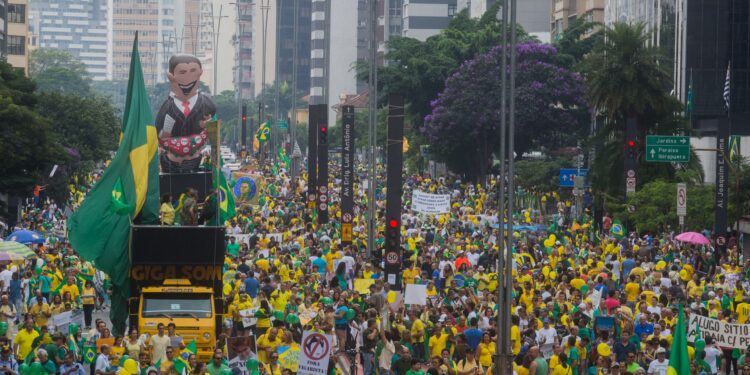In a crowded car wash in the southern Brazilia Hotel in the capital, Brazilia, a few were aware that the Posto Da Torre located in the laundry, was not only washing cars, but was also washing money.
Among them was some older workers, a number of tourists, and the most important of some curious journalists, and they are specifically those who started searching for “How and for those who washed the car wash money?”
That a corruption scandal comes out of an intercontinental company, a political party, or even a sports club, this is one of the usual seasonal news, but that a car wash is the first sacrifice of the largest corruption scandal in the history of Latin America, and perhaps in history, this requires interlocking threads and strange ties, between car wash in a Brazil neighborhood and the involvement of former heads, politicians and businessmen in corruption cases.
From Peru the story started
The Journalist of the IDL-RPORTROS (IDL-RIPORTROS) was Gustavo Guriti sitting in his office in 2011 when he was assigned to consider deals between the Brazilian construction company “Odyssey” and the Peru government after it became the main partner in public construction projects.
The company’s increasing money and repeated demand for new contracts in public construction projects in the country drew attention to Guriti, and he published a report on that without realizing that the wilderness that will be the fire of curiosity that the journalist will have to launch the flames of a cross -border investigation, after he realized that the issue has parties that exceed the borders of Peru.
While Guriti was leading investigations with his team in the newspaper, as the Brazilian police began suspected the use of the “Postu da Toury” station in money laundering, and what the police or journalist Guriti did not expect, both will find the other looking at the files of the Brazilian -owned Brazilian oil company.
On the side of Guriti, the smell was inevitably leading to Brazil, given the nationality of the construction company contracting with the Peruvian government, but in terms of the Brazilian police, the case was in its beginnings local and there is nothing to take it abroad.
Immediately after “Lava Gato” surfaced, Guriti began communicating with journalists from other countries to expand the investigations, so he started with the Panamanian investigative journalist Rolando Rodriguez, then the Brazilian investigative correspondent, Galmani Amadou, and in 2015, the cooperation resulted in obtaining a hard disk (flash memory) that contains more than two thousand pages of leaked diplomatic telegrams that It showed that the Brazilian Ministry of Foreign Affairs was pressuring the governments of other countries for the benefit of Oedberch and other Brazilian companies.
In 2017, after a large number of experienced investigative journalists from different Latin countries joined, one of them obtained an audio recording of a senior executive of Oedbercht company during his legal settlement contract with the United States, Brazil and Switzerland, during which he admitted to paying about 800 million US dollars, without specifying the recipient, and in which projects were, but he revealed the involvement of Brazilian presidents and their deputies.
But what about the Brazilian police washing station and investigations?
Police found that the car wash station was used to launder criminals through currencies, who led investigations to find out that they are employees of the largest executive director of the Brazilian oil -owned oil company “Petrobras”, which in turn is one of many other managers in other companies owned by the oil company, including Odebricht.
With the expansion of the investigations, it was found that the defendants paid about two billion dollars in bribes from Petrobras and the sub -companies, so that the Odeberch company established a whole section called “structural operations” to deal with bribes and “external payments” worth $ 780 million that went to political figures and prominent parties in Brazil and 12 other countries in Latin America alongside Angola and Mozambique.
https://www.youtube.com/watch?v=7hktjl7k7i
How did the case end?
About 170 people were convicted in the case and charged with 12 heads of state and former heads in countries such as Brazil, Peru and Panama, including the Brazilian President at the time, Lula da Silva, and resulted in the return of more than 600 million euros to Brazil’s accounts with a pledge to return more than two billion others.
This is not the most exciting part of the case, as the court in which it also faces faces accusations of political corruption, in what can be described as “rampant corruption.”
In 2019, the “The Instipt” website revealed messages showing that the main judge in the “Lava Gato” case Sergio Moro, conspired with the prosecutors to prevent President Lula da Silva from running for the 2018 elections in favor of his rival Jayer Bolsonaro, who was retreating in the survey rates, and then after his victory he was appointed as Minister of Justice.
After differences between the two men, Moro resigned from the ministry in 2020 and revealed the fact that Bolsonaro interfered directly in the case, which left a bad impression on the public opinion that he saw in Moro and his companions heroes in fighting corruption.
While President Bolsonaro announced “the elimination of corruption in Brazil”, it approached the Centrau alliance, which includes parties known to provide support in exchange for services that were at the heart of the “Lava Gato” scandal, in order to get it to win the 2022 elections without obstacles, but the result was the release of Da Silva and his victory in the presidential elections.



